

Wave. In physics, a wave is a disturbance or oscillation that travels through space and matter, accompanied by a transfer of energy.
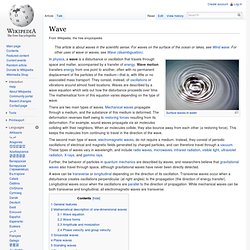
Wave motion transfers energy from one point to another, often with no permanent displacement of the particles of the medium—that is, with little or no associated mass transport. They consist, instead, of oscillations or vibrations around almost fixed locations. Waves are described by a wave equation which sets out how the disturbance proceeds over time. The mathematical form of this equation varies depending on the type of wave.
There are two main types of waves. The second main type of wave, electromagnetic waves, do not require a medium. Further, the behavior of particles in quantum mechanics are described by waves, and researchers believe that gravitational waves also travel through space, although gravitational waves have never been directly detected. General features[edit] A single, all-encompassing definition for the term wave is not straightforward. Physical constant. There are many physical constants in science, some of the most widely recognized being the speed of light in vacuum c, the gravitational constant G, Planck's constant h, the electric constant ε0, and the elementary charge e.
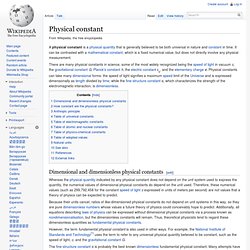
Physical constants can take many dimensional forms: the speed of light signifies a maximum speed limit of the Universe and is expressed dimensionally as length divided by time; while the fine-structure constant α, which characterizes the strength of the electromagnetic interaction, is dimensionless. Dimensional and dimensionless physical constants[edit] Whereas the physical quantity indicated by any physical constant does not depend on the unit system used to express the quantity, the numerical values of dimensional physical constants do depend on the unit used. Fundamental interaction. Fundamental interactions, also called fundamental forces or interactive forces, are modeled in fundamental physics as patterns of relations in physical systems, evolving over time, that appear not reducible to relations among entities more basic.
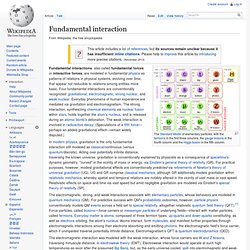
Four fundamental interactions are conventionally recognized: gravitational, electromagnetic, strong nuclear, and weak nuclear. Everyday phenomena of human experience are mediated via gravitation and electromagnetism. The strong interaction, synthesizing chemical elements via nuclear fusion within stars, holds together the atom's nucleus, and is released during an atomic bomb's detonation.
The weak interaction is involved in radioactive decay. (Speculations of a fifth force—perhaps an added gravitational effect—remain widely disputed.) In modern physics, gravitation is the only fundamental interaction still modeled as classical/continuous (versus quantum/discrete). Physical law. A physical law or scientific law, according to the Oxford English dictionary, "is a theoretical principle deduced from particular facts, applicable to a defined group or class of phenomena, and expressible by the statement that a particular phenomenon always occurs if certain conditions be present.
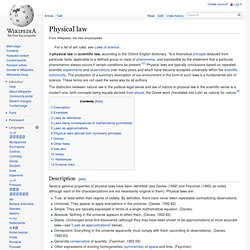
"[1] Physical laws are typically conclusions based on repeated scientific experiments and observations over many years and which have become accepted universally within the scientific community. Interaction. Field (physics) The magnitude and direction of a two-dimensional electric field surrounding two equally charged (repelling) particles.
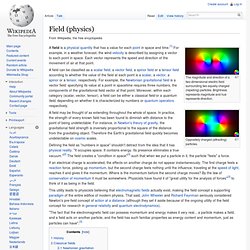
Brightness represents magnitude and hue represents direction. Oppositely charged (attracting) particles. A field may be thought of as extending throughout the whole of space. In practice, the strength of every known field has been found to diminish with distance to the point of being undetectable. Elementary particle. In particle physics, an elementary particle or fundamental particle is a particle whose substructure is unknown, thus it is unknown whether it is composed of other particles.[1] Known elementary particles include the fundamental fermions (quarks, leptons, antiquarks, and antileptons), which generally are "matter particles" and "antimatter particles", as well as the fundamental bosons (gauge bosons and Higgs boson), which generally are "force particles" that mediate interactions among fermions.[1] A particle containing two or more elementary particles is a composite particle.

Everyday matter is composed of atoms, once presumed to be matter's elementary particles—atom meaning "indivisible" in Greek—although the atom's existence remained controversial until about 1910, as some leading physicists regarded molecules as mathematical illusions, and matter as ultimately composed of energy.[1][2] Soon, subatomic constituents of the atom were identified. Overview[edit] Main article: Standard Model. Mass–energy equivalence. In physics, mass–energy equivalence is the concept that the mass of an object or system is a measure of its energy content.
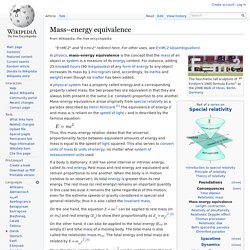
For instance, adding 25 kilowatt-hours (90 megajoules) of any form of energy to any object increases its mass by 1 microgram (and, accordingly, its inertia and weight) even though no matter has been added. A physical system has a property called energy and a corresponding property called mass; the two properties are equivalent in that they are always both present in the same (i.e. constant) proportion to one another. Mass–energy equivalence arose originally from special relativity as a paradox described by Henri Poincaré.[1] The equivalence of energy E and mass m is reliant on the speed of light c and is described by the famous equation: Thus, this mass–energy relation states that the universal proportionality factor between equivalent amounts of energy and mass is equal to the speed of light squared.
Nomenclature[edit]